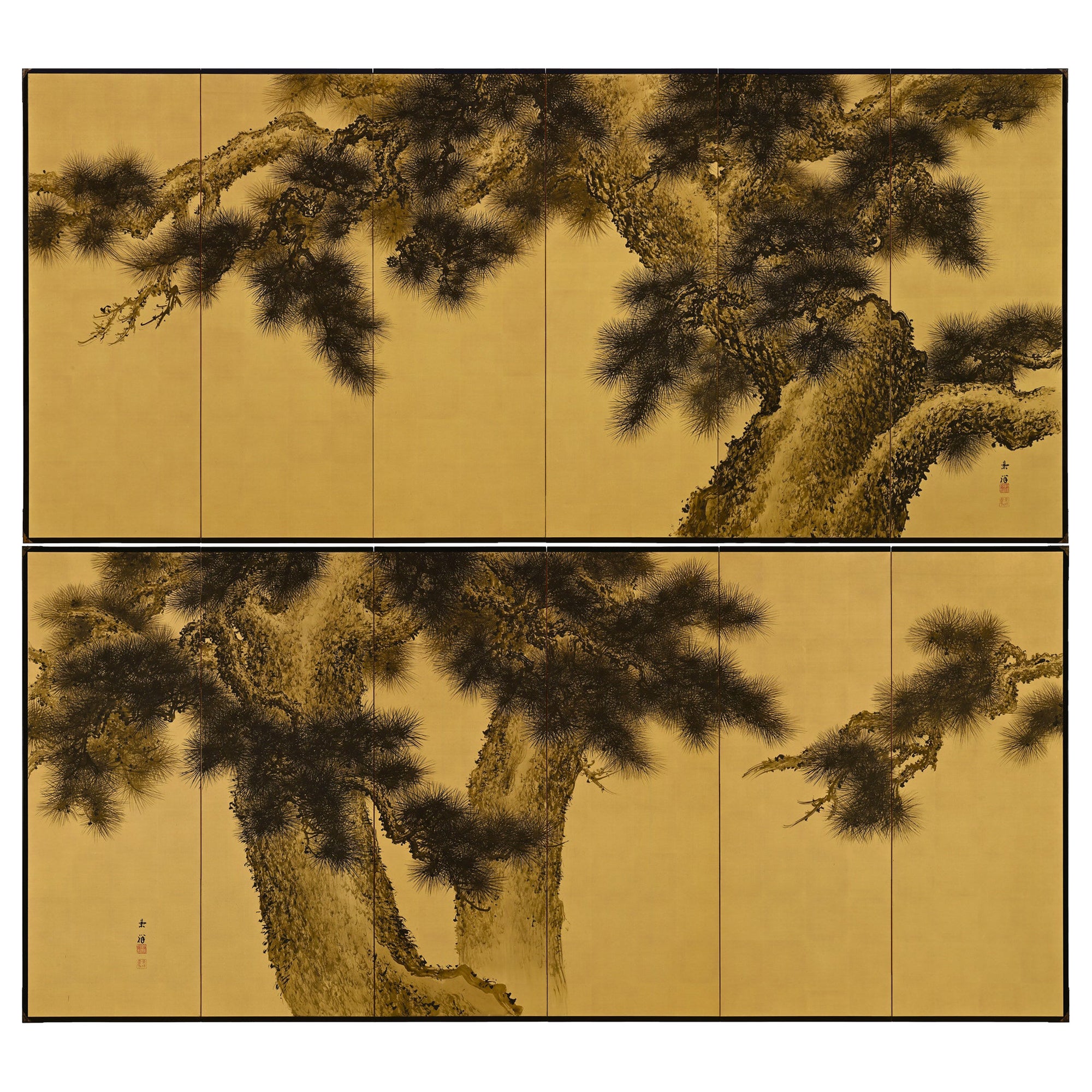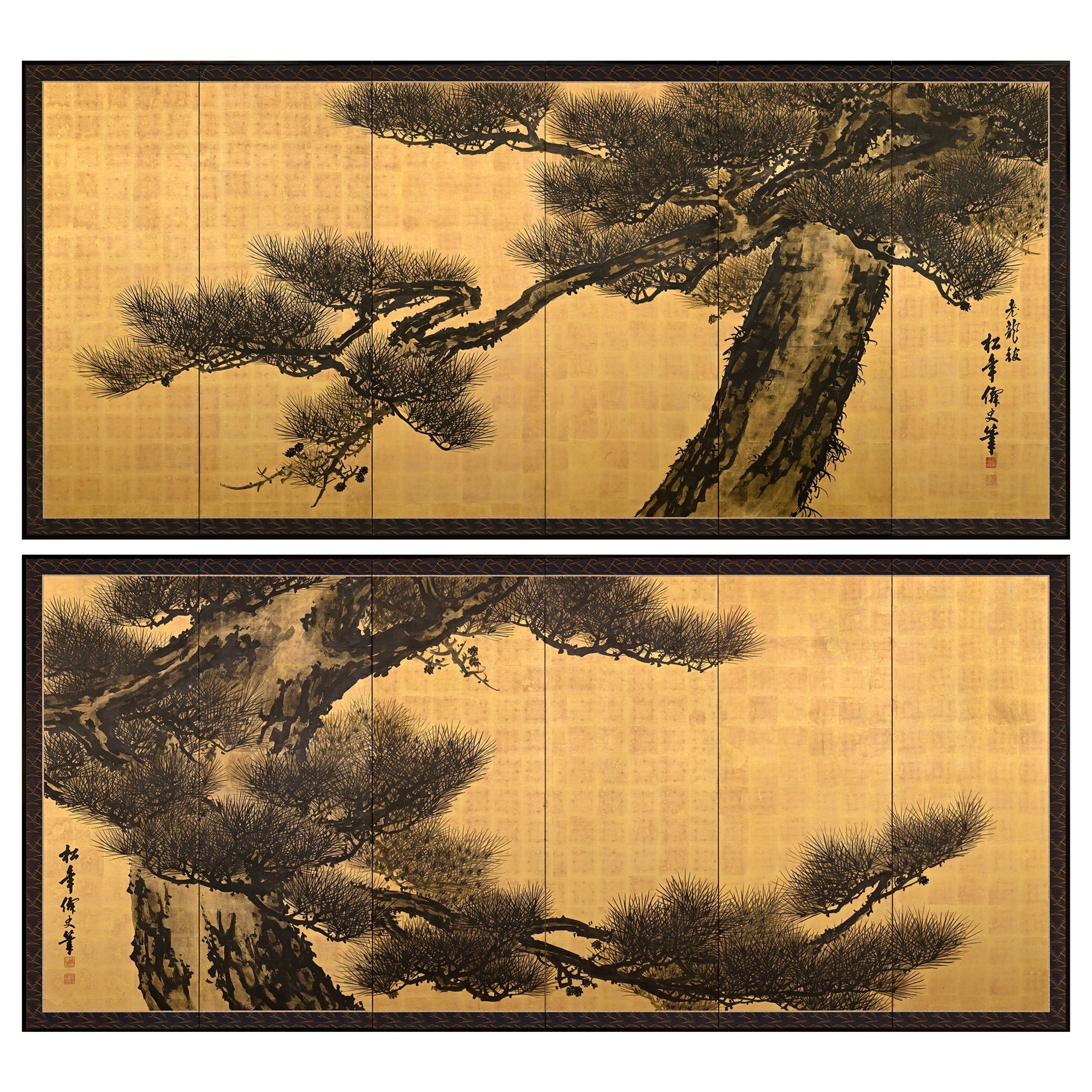Items Similar to Japanese Screen pair. Late 19th Century. Ink Pine Trees on Gold by Suzuki Shonen
Want more images or videos?
Request additional images or videos from the seller
1 of 14
Japanese Screen pair. Late 19th Century. Ink Pine Trees on Gold by Suzuki Shonen
About the Item
Suzuki Shonen (1848-1918)
Meiji period (1868-1912), late 19th century.
Twisted pines
Pair of six-fold screens. Ink on a gold leaf ground.
Signature:
Right screen: Shonen Senshi Sha
Left screen: Shonen Sha
Seal:
Shonen
Dimensions:
Each screen measures: W. 380 cm x H. 174 cm
Suzuki Shonen was one of the leading Japanese artists of the late 19th and early 20th centuries. Shonen had many powerful patrons, and his works were often lavishly mounted and frequently included personal motifs woven into the brocade fabrics. Shonen never worked from preliminary sketches (shita-e), but painted quickly and directly, in a bold, individual style. Shonen’s great technical skill in handling ink tonalities and striking brushwork became the signal features of his style. One of his most common themes was the pine tree, the “Sho” in his name, Shonen, being the Japanese character for "pine."
This pair of pine screens date to earlier in the artist’s career. His ink and brush styles were eclectic, drawing upon literati, Kano and Maruyama/Shijo school styles. Here he utilises the strong black outlines and broad brush of the Kano school, while refraining from the forcefulness of his later work. The pine trees are brought to the front of the composition and focus the viewer on the two-dimensional plane. The thinly outlined ground and minimalistic waterfall serve to heighten the monumentality of the towering pines. Their great age is expressed through their thick trunks, which Shonen contrasts dramatically to the angular branches and the sharply delineated needles. Slight changes of lighting allow full expression of the extraordinary visual impact of the scene, which has been painted on radiant, hand-beaten gold leaf. The brocade has been woven with bats among clouds.
Pairs of six-fold pine screens by the artist are held in the Metropolitan Museum of Art New York, the Indianapolis Museum of Art and the Art Gallery of New South Wales.
- Dimensions:Height: 68.5 in (173.99 cm)Width: 150 in (381 cm)Depth: 0.75 in (1.91 cm)
- Sold As:Set of 2
- Style:Meiji (Of the Period)
- Materials and Techniques:
- Place of Origin:
- Period:
- Date of Manufacture:circa 1890
- Condition:Wear consistent with age and use.
- Seller Location:Kyoto, JP
- Reference Number:1stDibs: LU2472317105612
About the Seller
5.0
Recognized Seller
These prestigious sellers are industry leaders and represent the highest echelon for item quality and design.
Gold Seller
These expertly vetted sellers are highly rated and consistently exceed customer expectations.
Established in 2001
1stDibs seller since 2016
59 sales on 1stDibs
Typical response time: 5 hours
- ShippingRetrieving quote...Ships From: Kyoto, Japan
- Return PolicyA return for this item may be initiated within 10 days of delivery.
More From This SellerView All
- Early 20th Century Japanese Screen Pair - Ink Pine Trees on GoldLocated in Kyoto, JPImao Keisho (1902-1993) Pine Trees Early 20th Century, Circa 1930 Pair of six-panel Japanese screens. Ink on silk and gold leaf. Dimensions: Each screen H. 67.5” x 148” (172 cm x 376 cm) A pair of monumental six-panel Japanese pine screens by the renowned Nihonga artist Imao Keisho. Here Keisho entirely removed the background and brought the pine trees to the surface of the painting. This simplification of the elements makes the scene exceptionally direct and compelling and injects a very modern...Category
Early 20th Century Japanese Showa Paintings and Screens
MaterialsGold Leaf
- 19th Century Small Japanese Screen Pair, Pine Trees and Vines on Gold LeafLocated in Kyoto, JPThis pair of screens depict just the middle sections of aged pine trees, painted in bold brush strokes on a background of gold leaf clouds. The trees are draped in vines, the lush cr...Category
Antique Mid-19th Century Japanese Edo Paintings and Screens
MaterialsGold Leaf
- Circa 1900 Japanese Pine Screen Pair. Aged Dragons by Suzuki Shonen.Located in Kyoto, JPSuzuki Shonen (1848-1918) Aged Dragons Meiji period (1868-1912). Circa 1900. A pair of six-panel Japanese screens. Ink and gold leaf on paper. As with the pair of Shonen pine scr...Category
Antique 1890s Japanese Meiji Paintings and Screens
MaterialsGold Leaf
- 17th Century Japanese Screen Pair by Soga Nichokuan, Hawks on Pine & Plum TreesLocated in Kyoto, JPHawks on plum and pine Soga Nichokuan (active circa 1625-1660) Pair of six-fold screens. Ink, mineral pigments, gofun, gold and speckled gold leaf on paper. Upper seal: H...Category
Antique 1640s Japanese Edo Paintings and Screens
MaterialsWood, Paper
- 19th Century Japanese Screen for Tea-Ceremony, Ink Bamboo and Plum on Gold LeafLocated in Kyoto, JPThree Friends of Winter Nakajima Raisho (1796-1871) Late Edo period, circa 1850 Ink and gold leaf on paper. This is a double-sided Japanese Furosaki or tea-ceremony screen from the mid 19th century; bamboo and plum on the front, young pines the back. It by Nakajima Raisho, a master painter of the Maruyama school in the late Edo and early Meiji periods. In this work Raisho combines exquisite ink brushwork with large open spaces of brilliant gold-leaf to inspire the viewers imagination. Rather than naturalism, he is searching for the phycological impression of the motifs, resulting in abstraction and stylization. His simplification of the motifs the result of looking to capture the inner nature of the objects. This art motif is known as Sho Chiku Bai, or the Three Friends of Winter. Evergreen pine connotes steadfastness, bamboo suggests both strength and flexibility, while plum blossoms unfurling on snow-laden branches imply hardiness. Combined, this trio is emblematic of Japanese new year. Chinese literati were the first to group the three plants together due to their noble characteristics. Like these resilient plants flowering so beautifully in winter, it was expected of the scholar-gentleman to cultivate a strong character with which he would be able to show the same degree of perseverance and steadfastness even during times of adverse conditions. The screen would have been placed near the hearth of a room used for the Japanese tea ceremony, shielding the fire from draughts and also forming a stimulating and decorative backdrop behind the tea utensils. It would have been used in the Hatsugama, or first tea-ceremony of the new year. Nakajima Raisho (1796-1871) originally studied under Watanabe Nangaku before entering the school of Maruyama Ozui. He was the highest ranking Maruyama school painter at the end of the Edo period and was known as one of the ‘Four Heian Families’ along with Kishi...Category
Antique Mid-19th Century Japanese Edo Paintings and Screens
MaterialsGold Leaf
- 17th Century Japanese Screen. Ink Plum Tree & Birds by Kano Naonobu.Located in Kyoto, JPKano Naonobu (1607-1650) Plum Tree and Birds Six-fold Japanese Screen. Ink and slight color on paper. In this evocative ink work spread over a six-panel folding screen, we see the consummation of the elegance and refinement of the Edo Kano school. This 17th century screen is a rare surviving example of a large-scale bird and flower painting by Kano Naonobu, the younger brother of Kano Tanyu...Category
Antique 17th Century Japanese Edo Paintings and Screens
MaterialsWood, Paper
You May Also Like
- Japanese Two-Panel Screen: Ink Landscape on SilkBy ShunyuLocated in Hudson, NYJapanese Two Panel Screen: Ink Landscape on Silk, Meiji period (1868 - 1912) painting of a man riding a mule on a pathway through the Kurotani mountains with a thatched roof shelter ...Category
Antique 19th Century Japanese Meiji Paintings and Screens
MaterialsSilk, Wood
- Japanese Two-Panel Screen Ink Painting of Palm Trees on PaperLocated in Hudson, NYJapanese two-panel screen: ink painting of Palm Trees on paper, Edo period (1787) beautiful painting of Japanese windmill palm trees. Ink paint...Category
Antique 18th Century Japanese Edo Paintings and Screens
MaterialsPaper, Silk, Wood
- Edo Period 19th Century Japanese Folding Screen Six Panels Flowers on Gold LeafBy Rimpa SchoolLocated in Brescia, ITClouds of gold, water and many colorful flowers: Japanese six-panel folding screen by Rimpa School. Hand painted with rice mineral pigments and inks on rice paper and gold leaf.Category
Antique Early 19th Century Japanese Edo Paintings and Screens
MaterialsGold Leaf
- Japanese Two-Panel Screen: Dramatic Splash by Suzuki GoroLocated in Hudson, NYSumi ink on Mulberry paper, with black lacquer trim and gilded bronze hardware. Signature reads: Suzuki Goro.Category
Mid-20th Century Japanese Paintings and Screens
MaterialsBronze
- Japanese Two Panel Screen Young Pine and Pine Cones on GoldLocated in Hudson, NYMineral pigments on gold leaf on mulberry paper with a silk brocade border.Category
Antique Early 1800s Japanese Paintings and Screens
MaterialsBrocade, Silk, Paper
- 19th Century Japanese Six Panel Screen: Silver Moon Rising Over Summer FieldLocated in Hudson, NYJapanese Six Panel Screen: Silver Moon Rising Over Summer Field. Rimpa Style painting of a moon rising over summer flowers and grasses, including cockscomb and blue bellflowers. Pa...Category
Antique Late 19th Century Japanese Meiji Paintings and Screens
MaterialsGold Leaf
Recently Viewed
View AllMore Ways To Browse
Screens With Fabrics
Pair Screens
Pair Of Screens
Japanese Gold Leaf
Gold Leaf Japan
Asia Gold Painting
Antique Japanese Screens
Antique Japanese Screen
Japanese Screens Antique
Japanese Screen Antique
19th Century Screens Asia
Screen Tree
Japanese Painting Tree
Screen With Trees
19th Century Wood Screens
Japanese Screen Black
Asian Gold Leaf Art
19th Japanese Screens





